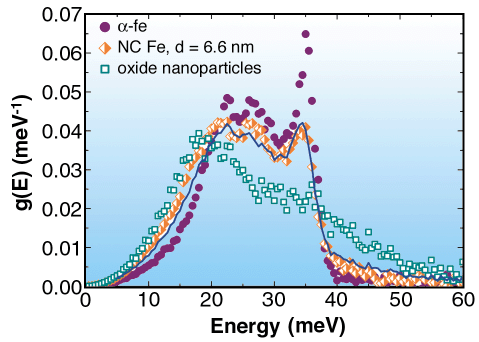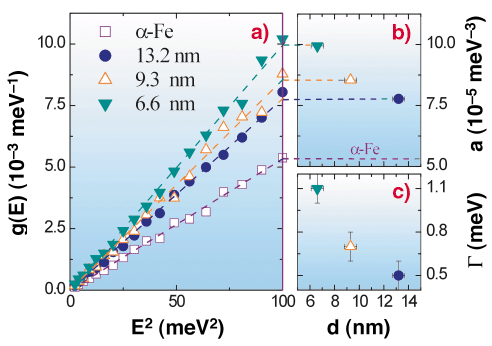- Home
- Users & Science
- Scientific Documentation
- ESRF Highlights
- ESRF Highlights 2002
- High Resolution and Resonance Scattering
- Scale Effects on the Vibrational Properties of Nanocrystalline Iron
Scale Effects on the Vibrational Properties of Nanocrystalline Iron
The investigation of vibrational dynamics in low-dimensional and nanostructured solids is a rapidly growing research field, powered by the interest in thermodynamic, conductive, and optical properties of mesoscopic systems [1]. A wealth of novel phenomena, such as phonon folding, phonon confinement, and vibrational interface states have been revealed in the last few years. A key role in this respect is played by the vibrational density of states (VDOS), g(E). In the VDOS of nanocrystalline (NC) materials, i.e., polycrystals with an ultrafine grain size d, both finite-size effects and interface-related phenomena due to the large fraction of disordered interfaces are expected. In particular, two basic questions are extremely relevant: (i) how does the VDOS scale with d, and (ii) is there a deviation from the usual Debye law g(E) = aE2 at low energies?
Nuclear inelastic scattering (NIS) of synchrotron radiation was applied to the determination of the VDOS in NC iron samples with different grain size, prepared by inert gas condensation. The oxidation degree of the samples (1-X) is defined as the atomic fraction of oxidised Fe atoms, obtained from X-ray diffraction and Mössbauer spectroscopy. NIS experiments were carried out on ID18, tuning the incident radiation in the ± 90 meV range around the transition energy of 57Fe (14.412 keV). A final bandwidth of 0.6 meV was achieved using a high-resolution monochromator, consisting of two (975) Si crystals in a dispersive (+,+) energy setting.
 |
|
Fig. 69: VDOS of NC iron (d = 6.6 nm), iron oxide nanoparticles, and reference |
In the NC samples, in comparison with a reference  -Fe foil, an enhanced population of low-energy modes and a broadening of the longitudinal peak at about 36 meV were observed (Figure 69). This softening can be explained only partially by oxidation of the grain interfaces: a linear combination Xg
-Fe foil, an enhanced population of low-energy modes and a broadening of the longitudinal peak at about 36 meV were observed (Figure 69). This softening can be explained only partially by oxidation of the grain interfaces: a linear combination Xg -Fe+(1-X)goxide does not fully account for the low-energy intensity. Here goxide is the VDOS measured for totally oxidised nanoparticles. The remaining excess modes are most likely ascribable to vibrations of atoms at the grain interfaces, with modified local environment and softened force constants. Most notably, the low-energy VDOS exhibits a g(E) = aE2 dependence over the whole range 1.5-15 meV for all measured samples (Figure 70a), and the coefficient a increases with decreasing d (Figure 70b).
-Fe+(1-X)goxide does not fully account for the low-energy intensity. Here goxide is the VDOS measured for totally oxidised nanoparticles. The remaining excess modes are most likely ascribable to vibrations of atoms at the grain interfaces, with modified local environment and softened force constants. Most notably, the low-energy VDOS exhibits a g(E) = aE2 dependence over the whole range 1.5-15 meV for all measured samples (Figure 70a), and the coefficient a increases with decreasing d (Figure 70b).
 |
|
Fig. 70: (a) low-energy VDOS vs. energy square of NC samples with different grain size. Dashed lines: best fits according to g(E) = aE2; (b)-(c) coefficient a and damping parameter |
Turning now to the broadening, we attribute it to the damping of phonons due to confinement in nanocrystals. A damping parameter  was determined by first convoluting the experimental
was determined by first convoluting the experimental  -Fe VDOS with a Lorentzian (with FWHM =
-Fe VDOS with a Lorentzian (with FWHM =  ) and then fitting the longitudinal peak of the NC VDOS through the aforementioned linear combination (solid line in Figure 69). The d-dependence of the parameter
) and then fitting the longitudinal peak of the NC VDOS through the aforementioned linear combination (solid line in Figure 69). The d-dependence of the parameter  (Figure 70c), indicates that phonon lifetime
(Figure 70c), indicates that phonon lifetime  ~ 2
~ 2 /
/ and mean free path
and mean free path  ~
~ 
 (with
(with  the phonon velocity) decrease with decreasing grain size. Assuming a reasonable value of
the phonon velocity) decrease with decreasing grain size. Assuming a reasonable value of  ~ 2500 m/s, a mean free path
~ 2500 m/s, a mean free path  ~ 3 nm is estimated for the sample with d = 6.6 nm.
~ 3 nm is estimated for the sample with d = 6.6 nm.
In conclusion, a d-dependent VDOS softening was revealed, and the Debye-like character of the soft modes was clearly demonstrated. This finding should clarify controversies recently emerged in the literature [2]. In addition, phonon confinement in nano-sized grains was observed, the damping parameter being correlated and consistent with the grain size. Both achievements were only possible thanks to the high-energy resolution of the experimental setup, which allowed us to investigate the VDOS at very low energies and to measure broadening features in the meV energy range.
References
[1] M.A. Stroscio, M. Dutta, Phonons in Nanostructures, Cambridge University Press, Cambridge, England, (2001).
[2] A. Kara, T.S. Raman, Phys. Rev. Lett. 81, 1453 (1998).
Principal publication and Authors
L. Pasquini (a), A. Barla (b), A.I. Chumakov (b), O. Leupold (b), R. Rüffer (b), A. Deriu (c), E. Bonetti (a), Phys. Rev. B 66, 073410 (2002).
(a) Department of Physics, University of Bologna and INFM (Italy)
(b) ESRF
(c) Department of Physics, University of Parma and INFM (Italy)



